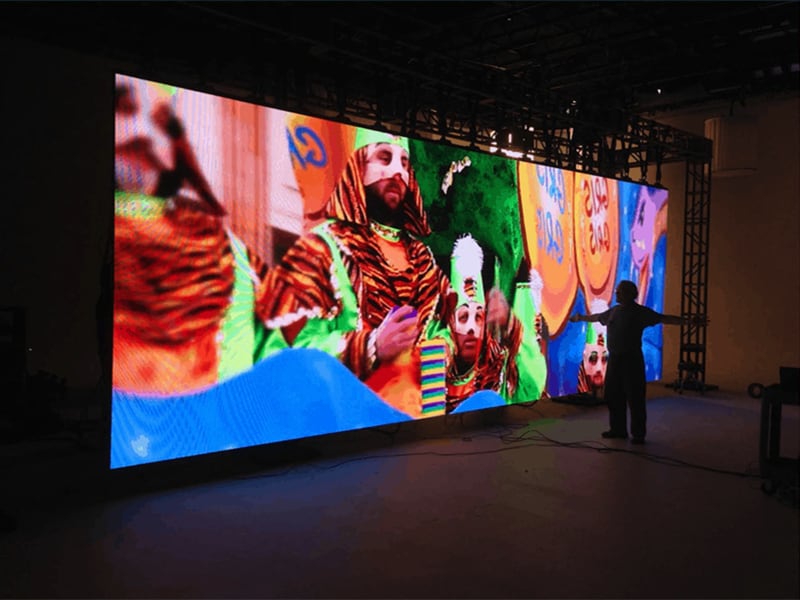Video Wall technology has come a long way since it was first introduced decades ago. Now commonly used in conferences, expos, education & corporate seminars and so on. Let’s have a look at some of the best uses of video walls, technology, applications and outcomes.

Video Wall – Corporate Goals
When implementing any visual technology, corporate goals associated with the strategy and overall outcome should be considered. Take for instance an event or a corporate seminar, the video wall comes in really handy as it displays the sponsored content, serves as an interactive way-finder in the arena, keeps the visitors entertained through creative visuals, engaging activities and more.
- Space & Placement Specifications
Before implementing or installing the video wall, get a full understanding of the space where it’s to be placed. Factors that come into play are size appropriation, pixel pitch, brightness and resolution, power requirement of the video wall. Other elements worth considering are the type of setup that can be for a tradeshow, a small booth, perhaps a large video wall that’s powerful and attractive enough to draw everyone’s attention and communicate your message clearly.
- Technical Aspects of Video Wall Content
Whether your video wall would shuffle different images, display different audio-visuals or simple text messages, content optimization is a must to deliver the right message to the right audience. That said, a video wall having micro fonts that are pixelated or unreadable, for a corporate display, would be most unprofessional which is why bold, sharp and pixel-perfect use of both text and image is a must.
Besides, a typical video wall has only seconds to grab audiences’ attention so you’ve to ensure perfection. Professional digital signage Dubai agencies mostly develop content with bigger screens in mind so you need to communicate your requirement to get the perfect outcome.
- Common Content Issues
- Lengthy & Useless Content: Whether yours is a sponsored message or simply a chunk of text, lengthy text with an unprofessional design is sure to go useless as it wouldn’t be communicated clearly. Since it’s a game of mere seconds to grab attention via video wall, keep the message and content short in a way that if your display is placed on a highway, a driver moving at 70mph speed can read it easily. A professional approach is limiting the video wall content length to around 10-seconds or maximum 15-seconds.
- Getting the Wrong Visual Hierarchy: A senseless or poorly defined visual hierarchy will surely raise more confusion or wouldn’t even reach the audience. The most important part of the message should always be the first to display. Change text and background colour to keep the element of attraction without your message getting lost in the noise.
- Non-unified Display: Video wall technology is about creating a unified display and not multiple screens pieced together. Imagine those black bars between the screens that can surely disrupt communication flow and appearance of the content. Your video wall hardware and software would dictate the appearance of the content on the screen. To make the most of the technological capabilities, layout of the content should be kept within the video wall dimension. Do note that technical attributes such as pixel pitch and screen resolution have a huge impact on display content quality.
- Understand the Pixel Pitch, Viewing Distance & Screen Resolution
Pixel pitch is the distance from the centre of an LED cluster/pixel to the centre of another LED cluster/pixel. The measurement is taken in millimetres which directly correlates to the display resolution, which is important for the best viewing experience. It determines the least required viewing distance for a clearer, sharper image; smaller the pixel pitch, higher would be the video wall resolution allowing users to clearly see the screen content from a certain distance.
A video wall that is larger than 100-inches with a 4-millimetre pitch contains above 200,000 pixels whereas pixel pitch of 6-millimetre on the similar display size will have less than 100,000. Rise in pixels results in the rise of cost so you need to consider this particular fact when planning and designing content for the video wall display.
- Brightness & Power Level
Understand the environment where your video wall would be displayed. Indoor or outdoor, the display unit’s brightness must be adjusted accordingly else it can have damaging effects on the quality of viewing, as well as screen.
Likewise, raising brightness during night time will further strain the eyes which is why it has to be adjusted according to the day and night as well as the environment where it’s installed. LED brightness is measured in ‘nit’. Here’re a few guidelines for appropriate determination of the nit requirements.
- Indoor Brightness: 1,000 – 1,500 nits
- Outdoor Brightness: 2,000 – 3,000 nits
- Brightness Under Direct Sunlight: LED panels need 5,000+ nits
Video Wall: Business Objectives
- All the information and data is displayed on video walls as interactive KPI dashboards
- Video walls enhance collaboration
- Keep staff up to date and align with the latest information
- Promote your brand among the customers
- For entertainment purposes during lunchtime; display live sports, TV broadcasts, news, weather etc.
- Easy to deploy, manage and maintain
- Provide communication and education
Future Vision for Video Wall Display Units
Technological advancement resulted in significant price drop for LEDs which eventually raised the demand for video walls. With more and more corporations adopting the technology, the future is surely bright.

